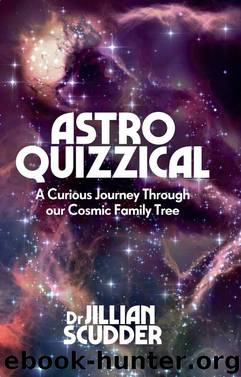Astroquizzical by Jillian Scudder

Author:Jillian Scudder [Jillian Scudder]
Language: eng
Format: epub
ISBN: 9781785783357
Publisher: Icon Books Ltd
Published: 2018-03-12T04:00:00+00:00
A stellar description
With the combination of the temperature of the star, as we trace it by its color, and the brightness of the star, which traces its physical size, we can piece together a lot of information about the vast family of stars that inhabit the Milky Way.
Stars that contain more mass than the Sun, and are physically larger, have a much higher gravitational pull than our own star. In resistance to the greater inward force, the outward pressure has grown much higher, cranking the temperature up internally. The surface temperature of such a star mirrors that internal temperature, making it glow a hotter, bluer, hue than our own Sun. Because the star is also physically larger, its brightness is also more intense than the Sun.
On the other hand, we have Sol’s smaller siblings, stars with much less mass than our star. These have less mass to crush inwards, and so they find a balance with less outward pressure from the material within the star. This less-dense balance means that the core of the star is never pressed into extremely high temperatures. With a lower temperature in the core, the surface is even cooler, and only manages to glow a dim red. The smaller amount of material also means a smaller star, which drops the brightness, on top of it only glowing a duller red color.
These two scenarios, plus our Sun, give a range of stellar possibilities: from bright, large, and blue, to faint, small, and red. But is that the only set of stars you can get? Or are there exceptions to this? To answer that question we have to take a census of the nearby family of stars, and check what the rest of them are doing. If we find that the brightest stars are all blue, and the faintest of them are all red, then the description above is as far as we need to go.
A family census like this is best illustrated by charting the brightness of a large number of stars against their respective colors. This kind of chart has been named the Hertzsprung-Russell diagram, or H-R diagram for short. If our faint red to bright blue relationship describes all stars, then we should expect to see a diagonal line running across the diagram, with nothing anywhere else.
We do see the diagonal line (color plate 12). This line is what we call the ‘main sequence’ of stars, and it is where all of the stars which are stably burning hydrogen in their cores sit. The vast majority of the stellar family members in our neighborhood and galaxy sit along that line. However, our Sun has a few unusual siblings, which are found in a totally different part of this diagram.
It’s useful to categorize stars more carefully than just into red, blue, and yellow like our Sun, and the H-R diagram is a good place to start dividing the stellar family into sets of cousins, where the stars within that group are all pretty similar to each other and can be compared as a group to other groups.
Download
This site does not store any files on its server. We only index and link to content provided by other sites. Please contact the content providers to delete copyright contents if any and email us, we'll remove relevant links or contents immediately.
Tools of Titans by Timothy Ferriss(7815)
Turbulence by E. J. Noyes(7702)
Astrophysics for People in a Hurry by Neil DeGrasse Tyson(5002)
Secrets of Antigravity Propulsion: Tesla, UFOs, and Classified Aerospace Technology by Ph.D. Paul A. Laviolette(4994)
Design of Trajectory Optimization Approach for Space Maneuver Vehicle Skip Entry Problems by Runqi Chai & Al Savvaris & Antonios Tsourdos & Senchun Chai(4843)
Room 212 by Kate Stewart(4739)
Pale Blue Dot by Carl Sagan(4618)
The David Icke Guide to the Global Conspiracy (and how to end it) by David Icke(4381)
A Journey Through Divination and Astronomy by Publishing Pottermore(4250)
Apollo 8 by Jeffrey Kluger(3512)
Goodbye Paradise(3446)
Losing the Nobel Prize by Brian Keating(3425)
COSMOS by Carl Sagan(3348)
The Five People You Meet in Heaven by Mitch Albom(3335)
How to Read Water: Clues and Patterns from Puddles to the Sea (Natural Navigation) by Tristan Gooley(3240)
Brief Answers to the Big Questions by Stephen Hawking(3239)
How to Read Nature by Tristan Gooley(3079)
The Order of Time by Carlo Rovelli(3073)
A Brief History of Time by Stephen Hawking(2819)
